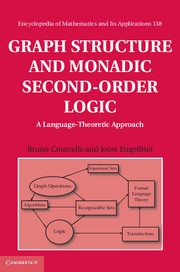Book contents
- Frontmatter
- Contents
- Foreword
- Introduction
- 1 Overview
- 2 Graph algebras and widths of graphs
- 3 Equational and recognizable sets in many-sorted algebras
- 4 Equational and recognizable sets of graphs
- 5 Monadic second-order logic
- 6 Algorithmic applications
- 7 Monadic second-order transductions
- 8 Transductions of terms and words
- 9 Relational structures
- Conclusion and open problems
- References
- Index of notation
- Index
8 - Transductions of terms and words
Published online by Cambridge University Press: 05 July 2012
- Frontmatter
- Contents
- Foreword
- Introduction
- 1 Overview
- 2 Graph algebras and widths of graphs
- 3 Equational and recognizable sets in many-sorted algebras
- 4 Equational and recognizable sets of graphs
- 5 Monadic second-order logic
- 6 Algorithmic applications
- 7 Monadic second-order transductions
- 8 Transductions of terms and words
- 9 Relational structures
- Conclusion and open problems
- References
- Index of notation
- Index
Summary
As explained in the introduction of Section 1.7, there are no appropriate finite-state automata or finite-state transducers that work “directly” on graphs. Thus, for graphs, the role of automata and transducers is taken over by monadic second-order logic: instead of being accepted by an automaton, a set of graphs is defined by a monadic second-order sentence; and instead of being computed by a transducer, a graph transduction is defined by a definition scheme consisting of monadic second-order formulas. With respect to automata, the original motivation for this approach was Theorem 1.16 (cf. Theorem 5.82): for terms and words monadic second-order logic and finite-state automata have the same expressive power.
The aim of this chapter is to show that, in a certain sense, the automata-theoretic characterization of monadic-second order logic for sets of terms and words (Theorem 1.16) can be generalized to transductions. This means of course, that the automata should produce output, i.e., that they are transducers. We will concentrate on transductions that are partial functions, and in particular on deterministic devices, i.e., parameterless definition schemes and deterministic transducers. For these, we will show that monadic second-order transductions of words correspond to two-way finite-state transducers, and that monadic second-order transductions of terms correspond to (compositions of) tree-walking transducers. These transducers are well known from Formal Language Theory.
A two-way finite-state transducer is a finite-state automaton with a two-way read-only input tape and a one-way output tape. The input word is placed on the input tape between endmarkers, and the transducer has a reading head that is positioned over a cell of the input tape, at each moment of time.
- Type
- Chapter
- Information
- Graph Structure and Monadic Second-Order LogicA Language-Theoretic Approach, pp. 578 - 620Publisher: Cambridge University PressPrint publication year: 2012

